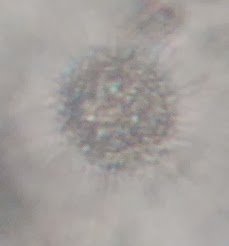Today's observations began with some new macrofauna (macro in my microaquarium, anyway :D), Annelids! I don't know where these guys have been hiding, but today they were all over the place!
Along with the many annelids, there were quite a few Paramecium hanging out.
These guys are unique for the green parts are chloroplasts they have acquired (Patterson 1996).
A rotifer was also spotted, but pictures were tough to get, he was in the soil for much of the observation.
A new find is Raphidiophrys.
This little protozoa was floating around near some paramesium and the annelids.
During observation, several vorticella were still present in the same area.
While I trying to capture Raphidiophrys on camera, he floated into the opening of vorticella, and was snatched up!
Finally, I spotted another diatom. It wasn't Surirella, from week one. This rod shaped diatom is difficult to identify.
Check back next week for my final observation!

























